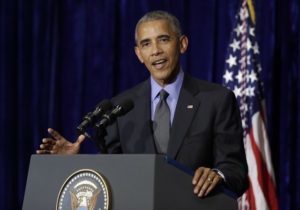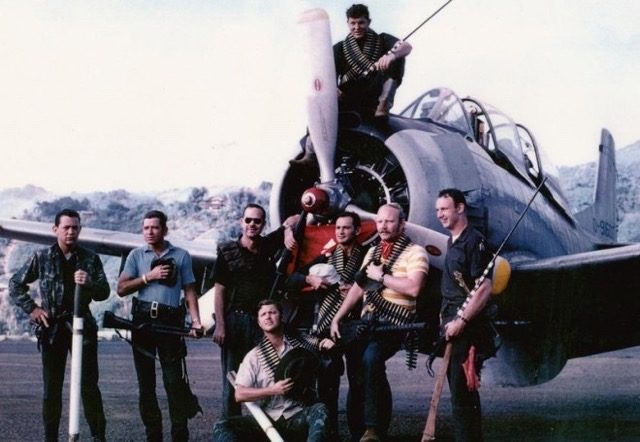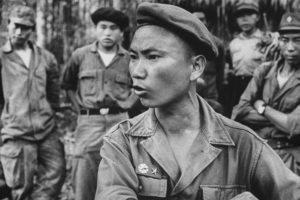I den første af mange fejl i løbet af Vietnamkrigen, så sagde Præsident Dwight Eisenhower i 1954, "Du har en række af dominobrikker stillet op, du slår den første ned, og hvad der vil ske med den sidste er at den med vished hurtigt vil falde over."
I january 1961, havde Eisenhower advaret sin efterfølger John F. Kennedy at Laos var det mest presserende udenrigspolitiske emne i verden og at han havde påbegyndt Operation Momentum i Laos, for at CIA kunne træne og bevæbne en lille styrke af Hmong klansmænd til at bekæmpe den kommunistiske Pathet Lao og deres Nordvietnamesiske støtter.
Men historien ville vise at "dominoteorien" i Sydøstasien var en fejltænkning af tragiske dimensioner. Thailand, Malaysia, Indonesien og Philippinerne ville alle selvsikkert modstå den kommunistiske indflydelse og ville uden tvivl have gjort det uden det blodbad a millioner af døde på tværs af Vietna, Cambodia og Laos.
Kommentar: Denne artikel er delvis oversat til dansk af sott.net fra: A deadly legacy: CIA's covert Laos war
As a young freelance journalist in 1965, I tried to cover the secret war in Laos. In the capital Vientiane, I encountered CIA pilots running supplies to the Hmong army in Long Chen and urged them, over many beers at the bar of the Continental Hotel, to take me along but without success.
Now, more than a half century later, author Joshua Kurlantzick, a senior fellow for Southeast Asia at the Council on Foreign Relations, has published a book, A Great Place to Have a War, based on recently declassified documents and interviews with major players behind the secret war in Laos.
He also analyzes how the conflict in Laos was the genesis of the CIA's support for clandestine paramilitary operations around the world, a pattern that continues through today. He concludes that the strategy in Laos set a sinister precedent for American presidents to conduct war without congressional or media oversight.
Kurlantzick writes, "The Laos program would balloon in men and budget. It would grow into a massive undertaking run by CIA operatives. CIA leadership saw that an inexpensive proxy war could be a template for wars when U.S. presidents were looking for ways to continue the Cold War without going through Congress or committing ground troops. The CIA leadership thought that Laos was a great place to have a war."
An army of hill tribes, mostly Hmong under the command of General Vang Pao, who initially led a ragged band of 5,000 guerrillas recruited and equipped by CIA officers. For 14 years, this irregular army fought the communists with Vang Pao's guerrilla forces finally numbering 100,000 irregular troops.
Over those years, more bombs were dropped on Laos than were dropped on Japan and Germany during World War II. By the end of the Vietnam War in 1975, some 200,000 Laotians, both civilian and military had been killed, including at least 30,000 Hmong, with another 750,000 Laotians made homeless by the bombing. Some 700 Americans, mostly CIA officers, contractors and U.S. military also died in the Laos conflict, although those American deaths would not be revealed for decades.
Today, Laos is a failed country still strewn with landmines and other ordnance that take the limbs and lives of Laotians every day. Only 1 percent of the unexploded ordnance is believed to have been cleared and an estimated 20,000 Laotians have been killed or injured since the bombing ceased.
A Destructive Debacle
By most measures, the CIA's war in Laos was a debacle that virtually destroyed a civilization. Plus, the war was "lost" from the U.S. government's perspective when the country disappeared into the communist Vietnamese orbit. But by the CIA's yardstick, it was a great success.
"In the opinion of many officers in the CIA Clandestine services, the paramilitary programs that the agency operated in Laos between 1963-71 were the most successful ever mounted," according to a quote from newly declassified CIA records cited by author Kurlantzick. "Small in numbers of personnel and even smaller in relative dollar costs, the CIA Laos operations shone in contrast to the ponderous operations of the US military forces in Vietnam."
CIA Director Richard Helms declared that the agency had proven itself in Laos and had tied down 70,000 North Vietnamese troops who might otherwise have fought Americans in Vietnam. Laos would become the template for a new type of large, secret war for decades to come.
In his book, Kurlantzick concentrates on four remarkable individuals who in partnership with the CIA would control the agency's war in Laos. All four have died recently, but Kurlantzick interviewed three of them.
There was Bill Lair, an American veteran of the U.S. Army's 3rd Division in World War II who joined the CIA in Bangkok to train Thai troops for a possible invasion by China. Lair, adept at the Thai and Lao languages, was later sent to Laos where he would become the first chief agent to deal with the Hmong warlord Vang Pao.
There was Vang Pao, who met Lair in January 1961 and promised that if Lair would provide weapons he would gather 10,000 men to be trained by the CIA. Vang Pao had a reputation of having a sharp mind but his rage, sadness and energy sometimes overtook his abilities and knowledge.
There was Ambassador William Sullivan, who took his post in Vientiane in 1964 and soon became the most powerful U.S. ambassador in the world, in charge of the secret war in Laos. Sullivan's power encompassed far more than the usual duties of filing reports on the political situation and attending diplomatic receptions. He had a strong respect for the CIA, unlike many U.S. ambassadors.
Sullivan also had a close relationship with President Lyndon Johnson, which Sullivan felt gave him a free hand to run the war in Laos. Called to testify before Congress, Sullivan drew the ire of Sen. William Fulbright, the chairman of the Senate Foreign Relations Committee, who complained: "We pretend Laos is a sovereign country. We are pretending we are not there? You are deceiving the American people and Congress."

The fourth principal in the Laotian war was Tony Poe, who had experienced heavy combat with the U.S. Marines island-hopping across the Pacific during World War II. When the Korean War broke out in 1950, Poe signed up to train Korean saboteurs. In 1961, Poe arrived in Laos to help train the Hmong who had become the center of Operation Momentum.
Poe was a hard-drinking combat trainer who sought opportunities to fight with the troops he had trained. He had a reputation of ruthlessness that included tales of cutting heads off North Vietnamese troops and dropping them from a helicopter. He is said to have shipped bags of ears cut from enemy soldiers to the U.S. Embassy in Vientiane.
In the mountains with his private army and drinking heavily, many of Poe's colleagues believed he had gone mad. However, in 1975, Poe was awarded a second CIA intelligence medal for "extraordinary heroism." It is believed Poe was the model for Marlon Brando's portrayal of Col. Kurtz in the film Apocalypse Now.
Enduring Lessons
The lessons from Laos had long-term effects on how the CIA would operate for years. After 1975, agents with Laos experience took over CIA stations all over the world and held senior jobs in agency headquarters. They brought with them a conviction the CIA could handle large-scale war fighting skills, reported Kurlantzick.
The secret war also had echoes up to the present. "The post-9/11 war on terror replicates the Laos war in other critical ways: CIA activities are totally unwatched by the public and the media. The strategies used to keep most of the war on terror secret ... would have been completely familiar to the CIA operatives running the Laos war."
In his last foreign trip, President Obama went to Laos, the first sitting U.S. president to ever do so. In a speech in Vientiane in September that got little notice back home, he offered no apologies, but pledged to increase funding for clearing unexploded bombs by $90 million over the next three years.

Kurlantzick didn't complete the research and transcript for his book until October, before the election of Donald Trump as president, but in an article for the Washington Post's Outlook section Jan. 22, he analyzed the new administration's likely policy toward the CIA:
"The incoming President seems eager to cut some of the agency's spies and analysts. Instead, power would flow to operatives in the field - those who help arm allied foreign military forces and manage drone strikes ... the Trump administration is poised to accelerate a transformation that has been happening since the 1960's, with the CIA becoming less focused on spying and more on paramilitary organizations with a central role in violent conflicts."
The first secret counter-terrorism operation under Trump's orders took place on Jan. 29 in Yemen against an "Al Qaeda affiliate" and appeared to have been a botched mission though the Trump administration hailed it as a success. It was reported to have been carried out by U.S. Special Operation Forces, with no mention of CIA participation.
A senior Navy Seal was killed during the raid and Yemeni officials reported 30 civilians also killed, mostly women and children. The New York Times said the civilian casualties triggered widespread anger across Yemen toward the U.S., adding to the tensions over President Trump's entry ban on Yemeni citizens.
Kurlantzick's A Great Place to Have a War could help Americans remember the chaos and destruction visited upon one of the world's most primitive societies. Whether the book will influence the future history of America's way of war remains to be seen.
Don North is a veteran war correspondent who covered the Vietnam War and many other conflicts around the world. He is the author of Inappropriate Conduct, the story of a World War II correspondent whose career was crushed by the intrigue he uncovered.





Læserkommentarer
dig vores Nyhedsbrev